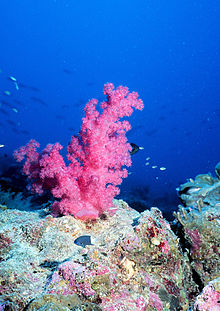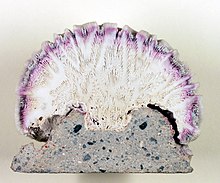User:Spaully/WIP Coral
Orders
- Subclass Alcyonaria (= Octocorallia)
- Alcyonacea (soft corals)
- Gorgonacea (sea fans, sea feathers)
- Subclass Zoantharia (= Hexacorallia)
- Antipatharia (black corals, thorny corals)
- Scleractinia (stony corals)
- Corallimorpharia
- Ptychodactiaria
_|---o Corallimorpharia _| |_|-* Numidiaphyllida | | |-o Scleractinia (stony corals) | |-----* Kilbuchophyllida | | _|---o Antipatharia (black corals, thorny corals) | | |_|-* Heterocorallia | |-| |-* Rugosa |-|_| |_|---* Heliolitida | | |---* Tabulata | |-------* Cothoniida |---------* Tabulacondia
Timeline
Vertical

Horizontal

Main Article
Geological history

Although corals first appeared in the Cambrian period[1], some 570 million years ago, they are extremely rare as fossils until the Ordovician period, 100 million years later, when Rugose and Tabulate corals became widespread.
Tabulate corals occur in the limestones and calcareous shales of the Ordovician and Silurian periods, and often form low cushions or branching masses alongside Rugose corals. Their numbers began to decline during the middle of the Silurian period and they finally became extinct at the end of the Permian period, 250 million years ago. The skeletons of Tabulate corals are composed of a form of calcium carbonate known as calcite.
Rugose corals became dominant by the middle of the Silurian period, and became extinct early in the Triassic period. The Rugose corals may be either solitary or colonial, and like the Tabulate corals their skeletons are also composed of calcite. The height of their development today. Their fossils may be found in small numbers in rocks from the Triassic period, and they are relatively common fossils in rocks from the Jurassic and Cretaceous periods as well as the Caenozoic era. The skeletons of Scleractinian corals are composed of a form of calcium carbonate known as aragonite. Although they are geologically younger than the Tabulate and Rugose corals, the aragonite skeleton of scleractinian corals does not tend to preserve well, so it is often easier to find fossils of the more ancient Tabulate and Rugose corals.
At certain times in the geological past corals were very abundant, just as modern corals are in the warm clear tropical waters of certain parts of the world today. And like modern corals their fossil ancestors built reefs beneath the ancient seas. Some of these reefs now lie as great structures in the midst of sedimentary rocks. Such reefs can be found in the rocks of many parts of the world including those of the Ordovician period of Vermont, the Silurian period of the Michigan Basin and in many parts of Europe, the Devonian period of Canada and the Ardennes in Belgium, and the Cretaceous period of South America and Denmark. Reefs from both the Silurian and Carboniferous periods have been recorded as far north as Siberia, and as far south as Australia.

However, these ancient reefs are not composed entirely of corals. Algae and sponges, as well as the fossilized remains of many echinoids, brachiopods, bivalves, gastropods, and trilobites that lived on the reefs help to build them. These fossil reefs are prime locations to look for fossils of many different types, besides the corals themselves.
Corals are not restricted to just reefs, many solitary corals may be found in rocks where reefs are not present (such as Cyclocyathus which occurs in the Cretaceous period Gault clay formation of England).
As well as being important rock builders, some corals are useful as zone (or index) fossils, enabling geologists to date the age the rocks in which they are found, particularly those found in the limestones of the Carboniferous period.
Environmental effects on coral


Corals can be sensitive to environmental changes, and as a result are generally protected through environmental laws. A coral reef can easily be swamped in algae if there are too many nutrients in the water. Coral will also die if the water temperature changes by more than a degree or two beyond its normal range or if the salinity of the water drops. In an early symptom of environmental stress, corals expel their zooxanthellae; without their symbiotic unicellular algae, coral tissues then become colorless as they reveal the white of their calcium carbonate skeletons, an event known as coral bleaching[2].
Scientists have predicted that over 50% of the coral reefs in the world may be destroyed by the year 2030[3].
Many governments now prohibit removal of coral from reefs to prevent damage by divers taking pieces of coral. However this does not stop damage done by anchors dropped by dive boats or fishermen. In places where local fishing causes reef damage, such as the island of Rodrigues, education schemes have been run to educate the population about reef protection and ecology.
A combination of temperature changes, pollution, and overuse by divers and jewelry producers has led to the destruction of many coral reefs around the world. This has increased the importance of coral biology as a subject of study. Climatic variations, such as El Niño-Southern Oscillation (ENSO), can cause the temperature changes that destroy corals. For example the hydrocoral Millepora boschmai, located on the north shore of Uva Island (named Lazarus Cove), Gulf of Chiriquí, Panamá, survived the 1982-83 ENSO warming event, but during the 1997-98 ENSO all the surviving colonies bleached and died six years later [4].
Uses

Local economies near major coral reefs benefit from recreational scuba diving and snorkeling tourism, however this also has deleterious implications such as removal or accidental destruction of coral.
Ancient coral reefs on land are often mined for limestone or building blocks ("coral rag"). An example of the former is the quarrying of Portland limestone from the Isle of Portland. Coral rag is an important local building material in places such as the east African coast.
Red shades of coral are sometimes used as a gemstone, especially in Tibet. In vedic astrology, red coral represents Mars. Pure red coral is known as 'fire coral' and it is very rare because of the demand for perfect fire coral for jewellery-making purposes.
Some coral species exhibit banding in their skeletons resulting from annual variations in their growth rate. In fossil and modern corals these bands allow geologists to construct year-by-year chronologies, a kind of incremental dating, which combined with geochemical analysis of each band, can provide high-resolution records of paleoclimatic and paleoenvironmental change[5].
Certain species of corals form communities called microatolls. The vertical growth of microatolls is limited by average tidal height. By analyzing the various growth morphologies, microatolls can be used as a low resolution record of patterns of sea level change. Fossilized microatolls can also be dated using radioactive carbon dating to obtain a chronology of patterns of sea level change. Such methods have been used to used to reconstruct Holocene sea levels[6].
References
- ^
Pratt, B.R. (2001). "12: Ecology and Evolution of Cambrian Reefs". Ecology of the Cambrian Radiation. Columbia University Press. p. 259. ISBN 0231106130.
{{cite book}}:|access-date=requires|url=(help); Check date values in:|accessdate=(help); External link in|chapterurl=|chapterurl=ignored (|chapter-url=suggested) (help); Unknown parameter|coauthors=ignored (|author=suggested) (help) - ^ Hoegh-Guldberg, O. (1999). "Climate change, coral bleaching and the future of the world's coral reefs" (PDF). Marine and Freshwater Research. 50 (8): 839–866.
- ^
Norlander (8 December 2003). "Coral crisis! Humans are killing off these bustling underwater cities. Can coral reefs be saved?(Life science: corals)". Science World.
{{cite magazine}}: Check date values in:|date=(help) - ^
Glynn, P.W. (2001). "History of significant coral bleaching events and insights regarding amelioration" (PDF). Coral Bleaching and Marine Protected Areas: Proceedings of the Workshop on Mitigating Coral Bleaching Impact Through MPA Design. Bishop Museum, Honolulu, Hawaii, 29-31 May 2001: 36–39.
{{cite journal}}: Cite has empty unknown parameter:|month=(help) - ^
Schrag, D.P. and Linsley, B.K. (2002). "Corals, Chemistry, and Climate". Science. 296 (8): 277–278. PMID 11951026.
{{cite journal}}: CS1 maint: multiple names: authors list (link) - ^
Smithers, S.G. and Woodroffe, C.D. (2000). "Microatolls as sea-level indicators on a mid-ocean atoll". Marine Geology. 168 (1–4): 61–78.
{{cite journal}}: Unknown parameter|month=ignored (help)CS1 maint: multiple names: authors list (link)
